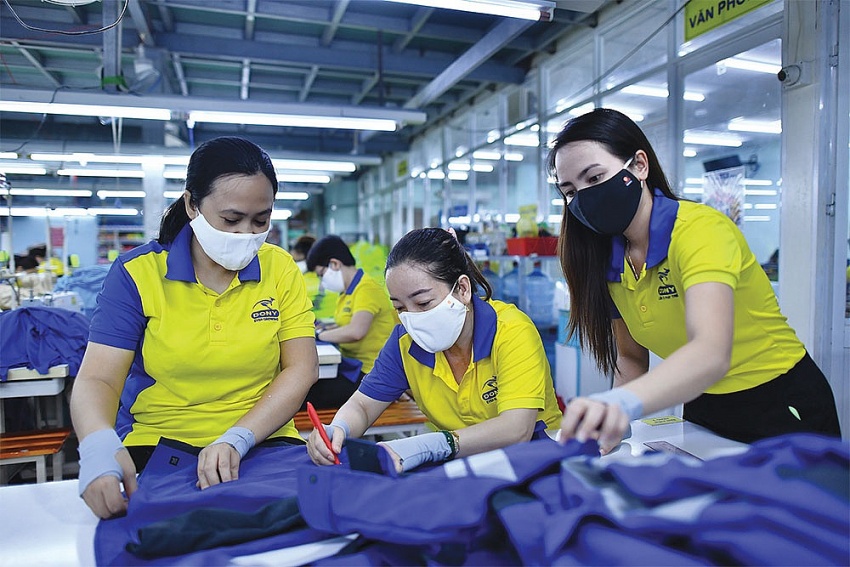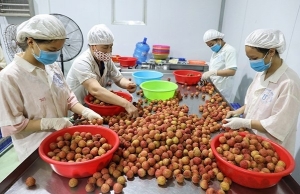Export boost paramount for recovery
 |
| There has been shrinking demand for exports in many of Vietnam’s key markets, photo Le Toan |
The most updated figures from the Ministry of Industry and Trade (MoIT) show that Vietnam’s goods export turnover in August reached $32.4 billion, up 7.7 per cent on-month.
Vietnamese exporters raked in $8.43 billion, up 8.7 per cent, and foreign exporters fetched $23.9 billion, including crude oil exports, up 7.3 per cent. This hints at domestic exporters performing better than foreign ones.
“August is the month with the highest export turnover over the past year, and it has marked the fourth consecutive month with export growth,” said Deputy Minister of Industry and Trade Phan Thi Thang.
Vietnam’s export turnover has been bouncing back, at $27.86 billion in May, $29.4 billion in June, and $30 billion in July. It is expected that the export situation will continue improving from now until the year’s end, with global demand for exports to increase on the back of the Christmas period, the MoIT said.
The ministry attributes the export recovery to the government’s synchronous and positive solutions to help enterprises deal with difficulties and expand export markets.
“We have been able to obtain new loans at banks with preferential lending rates. Export and import procedures have also been simplified, enabling us to boost exports to the US, South Korea, and Japan,” said Cao Hoang Huong, vice general director of Tan Viet Garment JSC in Hanoi.
Tan Viet’s export revenue reached about VND600 billion ($25.3 million) last year, and about VND300 billion ($12.76 million) in the first eight months of this year.
Its performance is improved compared to the whole garment and textile sector, which has suffered from an on-year 15 per cent reduction in export turnover so far this year.
However, Huong said, as compared to the same period last year, her company’s eight-month export value is still 5 per cent lower.
“This is due to difficulties in other markets such as ASEAN and Europe. Currently, we have export orders for October only, and not November or December, meaning we are having to seek more foreign partners both online and offline now.”
Despite signals of recovery, Vietnam’s August export turnover remained 7.6 per cent lower than that in the corresponding period last year due to weak demand from global markets. Vietnamese and foreign exporters (including crude oil exports) suffered from an on-year drop of 2.5 and 9.3 per cent, respectively.
The World Bank forecasted that Vietnam’s economy is expected to grow by 4.7 per cent in 2023, with a slow projected recovery to 5.5 per cent in 2024 and to 6 per cent in 2025.
“The growth projection assumes a moderate recovery in goods exports during the second half of 2023, especially the fourth quarter, based on a gradual recovery of demand from the European Union and United States,” the World Bank stated.
Looking ahead to 2024, economic growth is projected to be driven by a moderate recovery in exports and imports, in line with the expected rebound in global growth, as well as improvements in private investment, it added.
However, the MoIT has also issued a warning that Vietnam’s key growth momentum such as investment, export, and consumption are facing massive challenges, which have dented the country’s exports.
In the first eight months of this year, Vietnam’s total export turnover is estimated to have hit $227.7 billion, down 10 per cent on-year. Vietnamese exporters earned $59.9 billion, down 9.2 per cent and accounting for 26.3 per cent of the country’s total export turnover; and foreign-invested exporters fetched $167.8 billion, down 10.3 per cent and holding 73.7 per cent of total.
The MoIT ascribed the 2023 export situation thus far to global geopolitical tensions causing a shrink in demand for exports in many key export markets of Vietnam, especially in the first half of this year.
“Many major economies which are Vietnam’s major export partners reduced the spending on ordinary and luxury items. This has caused a drop in such export orders, while the country’s industrial sectors are largely export-oriented, relying on the global market as domestic outputs has far exceeded the domestic demand,” said Deputy Minister of Industry and Trade Do Thang Hai.
Especially when it comes to many sectors such as garments and textiles, footwear, aquatic products, and electronics, only 10 per cent are consumed at home and the remainder is for export, Hai explained.
In an example, mobile phones and their spare parts are reported to have reached an eight-month export turnover of $33.94 billion, down 15.4 per cent on-year.
Meanwhile, electronics, computers, and their spare parts – which are mainly produced by firms such as Samsung, LG, Jing Gong, Daewoo Vietnam, Genesistek Vina, and FC Vietnam – have earned a total eight-month export turnover of 36.15 billion, down 18.3 per cent as compared to that in the corresponding period last year.
 | Export carbon tax options on the table Two options for enacting a carbon tax scheme have been proposed to mitigate the impact of the EU’s carbon border adjustment mechanism on exporters. |
 | Compliance with quality standards – a must to bolster fruit exports: insiders Farmers and businesses must improve product quality, and strictly follow the rules of origin and ensure food safety to boost fruit exports, experts said. |
What the stars mean:
★ Poor ★ ★ Promising ★★★ Good ★★★★ Very good ★★★★★ Exceptional
Related Contents
Latest News
More News
- Mondelez Kinh Do - a chapter of purpose-led leadership in Vietnam (December 18, 2025 | 09:44)
- VNPAY services receive the highest-level PCI DSS international security certificates for six consecutive years (December 17, 2025 | 23:47)
- PPL extends its reach into ASEAN (December 17, 2025 | 15:44)
- Over 600 BUV graduates meeting quality benchmarks across triple quality assurance levels (December 17, 2025 | 13:00)
- HEINEKEN Vietnam partners with Ho Chi Minh City Traffic Police on road safety drive (December 17, 2025 | 09:42)
- BUV and China’s CSCSE sign MoU to boost educational cooperation (December 17, 2025 | 08:00)
- PVT Logistics honoured with ‘Fast Enterprise Award’ at APEA 2025 (December 16, 2025 | 18:22)
- Empowering Sustainable Data Centers with Smart Infrastructure Solutions (December 16, 2025 | 13:59)
- Vietjet wins gold ESG transport sustainability award in Taiwan (China) (December 13, 2025 | 22:03)
- Legal framework completed for national digital transformation (December 13, 2025 | 21:55)

 Tag:
Tag:






















 Mobile Version
Mobile Version